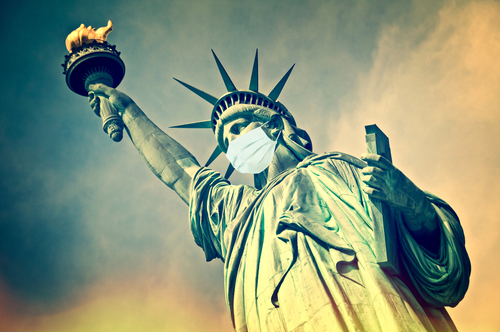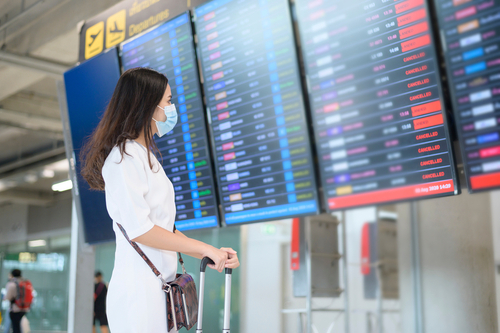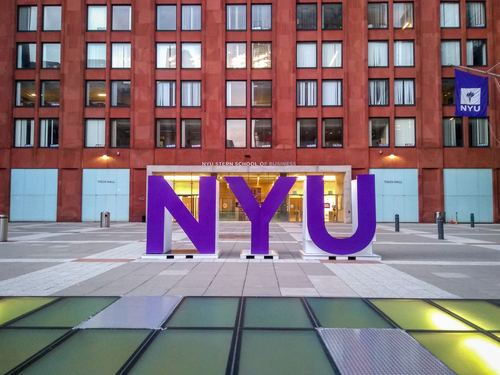The last flight home: A Filipino student’s escape from New York
We boarded one of the last few flights back to Manila, with empty rows on what usually was a fully booked flight. We were set to arrive exactly on March 20, when the international travel ban in the Philippines was taking effect.
It was our first spring break in New York. We had it all planned—restaurant reservations in the East Village, excursions to Museum Mile, and shopping trips to SoHo.
But then New York reported its first case of COVID-19. Then more and more cases were reported. And instead, we were walking around deserted streets, riding empty trains, and ordering delivery from restaurants that would never open their doors again. It was a foreshadowing of the New York that would soon be the epicenter of the pandemic.
New York University (NYU)—where I’m taking a Master’s degree in Publishing—suddenly announced that remote classes would continue until the end of the semester.
They were evacuating student halls and urging international students to go back to their home countries. Back in the Philippines, friends and family were telling me and my Filipino roommates about lockdowns, curfews, and police-guarded checkpoints.

We were stuck. Do we stay put in New York and just wait out the height of the pandemic not knowing when it’ll end or when we’ll be able to go back to Manila? Or do we go back home, also not knowing if and when we’ll be able to go back to New York?
After a few frantic calls with our parents, we found ourselves booking a flight home. It was important for us to be with our families at such an uncertain time. We were also worried that the healthcare in the US would cost too much if ever we did get sick. After all, we could always attend the rest of the Spring semester from home. We hastily packed our bags and cleaned our rooms. Little did we know it was going to be the last time we’d see our apartment.
We boarded one of the last few flights back to Manila, with empty rows on what usually was a fully booked flight. We were set to arrive exactly on March 20, when the international travel ban in the Philippines was taking effect. After us, there were only sweeper flights that were needed and requested by stranded Filipinos in different countries.
Some people at JFK were wearing full-coverage PPE. At check-in, we saw that they were Chinese passengers flying to China.
Hundreds of schools across the US, led by Harvard and MIT, filed lawsuits against ICE to defend their students. ICE officially rescinded the deportation rules on July 15.
We were almost jealous of how prepared they were even though we were wearing two layers of surgical masks, spraying alcohol on our hands every time we touched something, and had a bag full of extra clothes to change into upon landing in Manila.
Not everyone at the airport was wearing masks, but then again, not everyone knew the gravity of the situation just yet.
It was eerie to walk down the ramps of NAIA 1 to an empty pick-up area. No shouts of joy from families of OFWs finally reunited with their loved ones, no guards whistling at cars signalling them to move, no passengers shouting into their phones trying to describe what bay they were at.
Seeing Manila’s thoroughfares as empty as New York’s train stations brought with it an amazement at seeing something for the first time—but also dread at how big of a deal something had to be to cause it.
US IMMIGRATION POLICIES ON STUDENT VISAS
Rebecca Orbe, a fellow NYU grad student taking up Integrated Marketing Communications, opted to stay behind when everyone else was leaving New York.
She was working on-campus at NYU’s athletics department for extra income, but since all events had been cancelled, her job was also put on hold. She considered filing for a leave of absence because plans were all up in the air. But her professor talked her out of it. “He said, ‘Think of it this way: While everybody was running away because of the pandemic, at New York’s worst, you stayed. And after everything, you can say that you fought when the world was in chaos.’”

The talk got to her and she decided to stay put. “He told me to find a way to make the circumstances work for me.” She got an internship from her professor and has been working remotely since the summer.
Her decision was further reinforced when she talked to an advisor who told her going on leave would mean giving up her internship opportunities.
Since everything was still unclear, she might have to reapply for another student visa. It could also mean that she won’t be able to get a job in the US after graduating even if her current student visa allows for one year of work.
We were stuck. Do we stay put in New York and just wait out the height of the pandemic? Or do we go back home, also not knowing if and when we’ll be able to go back to New York?
This is what it’s like to be an international student in the United States—always having to calculate your next move based on the domino effect it has on your future plans. And you have to make your decision within the context of the laws and regulations that are constantly changing.
That’s what happened when the US Immigration and Customs Enforcement (ICE) made an announcement regarding international students on July 6.
They said that if international students with F1 and M1 visas were only attending online classes in the US, they would have to leave the country because of the pandemic.
This also meant that international students, whether they went home or not, would be forced to go to in-person classes and risk their health just so they won’t be deported and have their visas cancelled.
Millions of students were alarmed and started planning transfers to schools with in-person classes. Student advisors were sending out emails to assure students they were doing their best to find workaround solutions.
The new policy meant I couldn’t go back to the US unless I was willing to attend a class in person. I had to leave New York so I wouldn’t get sick so it felt counterproductive to return and just put myself in danger anyway. Was I willing to put months of isolation to waste just to save my student visa? It felt unfair that I had to choose.
When Rebecca heard of the announcement, she was thankful that NYU was already offering blended classes so she wouldn’t have to leave. Still, she was worried about the other schools, like Harvard and Princeton, which decided to go fully online.

“I have a few friends from other universities who were really panicking,” she says. But with border rules such as that, the challenges go beyond school and education.
Rebecca shares, “I have a cousin who also studies in New York and her mom—my aunt—passed away a month ago. And my cousin couldn’t even go home.”
She continues, “It’s one of the things that being an international student teaches you—how to be strong for others and how to be strong for yourself kasi wala ka talagang magagawa, ‘di ka talaga puwedeng umuwi. Even her dad was telling her to just stay.”
She and her cousin had to attend the wake and the funeral in the Philippines via Zoom. “That’s really what you learn as an international student—that if you don’t have family here by blood, you find family in other people to get you through things, especially during these tough times.”
Hundreds of schools across the US, led by Harvard and Massachusetts Institute of Technology (MIT), filed lawsuits against ICE to defend their students. ICE officially rescinded the rules on July 15, letting international students breathe a collective sigh of relief.
BLENDED CLASSES
The much-discussed fall semester is now in full swing and NYU has both online-only and blended classes. In NYU, all students—whether studying remotely or in-person—are required to watch a video and answer a survey about safety guidelines on campus.
Students are required to take a COVID-19 test before attending school and all members of the university community are required to wear face coverings. The school is also providing masks, sanitizers, and other protective equipment for free at certain pickup locations within the campus.
Students who are coming from other countries are urged to take a test before leaving for New York. But this won’t exempt them from testing again once they’re in New York.
Students living on- and off-campus are required to quarantine for 14 days. Some are also required to take two tests, one within 24 hours of arriving in New York and another 7-10 days after the initial test. If more than 5% of the student population test positive, remote classes will automatically be mandated.
But, of course, not everyone has been compliant. After the first week of school, NYU has already suspended 20 students for violating the guidelines.

Rebecca says she learns better in the classroom so she opted to attend her classes in person and plans to do so as long as she feels safe. “I was testing it out to see if the set-up was okay and with how NYU did it, I felt more at ease with it. It felt like we were the only class in the building,” she says.
“We’d ask each other if we were the only people there because we didn’t see any other people in the building. It’s a shared building with other corporate offices and even the offices aren’t fully open yet.” Only nine students and a professor are allowed in the classroom, for a maximum of 10 people. Students are also required to sit on the same seat throughout the whole semester to make contact tracing more efficient in the event of a positive case.
Meanwhile, my night classes in New York have become early-morning rituals in Manila thanks to the 12-hour difference. My professor’s camera would be set up at the back of the classroom and we’d see our faces projected on the screen while our professor talks in front of it.
My night classes in New York have become early-morning rituals in Manila. I’d get the occasional question if those were roosters crowing in the background. Yes, they were. It was 6 in the morning in Manila, I’d explain.
One or two of our classmates would be there in person while also on the Zoom call. I’d get the occasional question if those were roosters they could hear crowing in my background. Yes, they were. It was 6 in the morning in Manila, I’d explain.
They’d be amazed I was up so early for class and professors would even thank me for dealing with the time difference.
But really, there’s not much to it. It’s just another adjustment we have to make. As international students, we’ve always had to handle some sort of difficulty just to get the same quality education and job opportunities as our American counterparts. The ungodly hours, unexplainable regulations, and extra requirements are just some of them.
Rebecca says she’ll continue her internship, look for a new one when it ends, and hopefully get a job in the US after graduating. This would presumably be the same script for a lot of other students studying abroad.
When this is all over and it’s safe enough, students who went home are sure to book a flight back to New York or wherever it is they’re studying. They’ll make plans with their friends that will actually push through. It might not all be the same, but the empty streets will be once again full of people making their circumstances work for them—Filipino students included.



